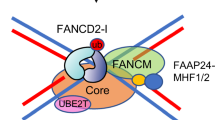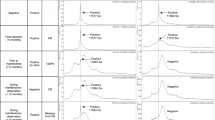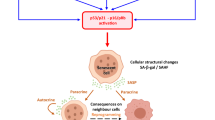Abstract
Approximately 25% of patients with Fanconi anemia (FA) have evidence of spontaneously occurring mosaicism as manifest by the presence of two sub-populations of lymphocytes, one of which is hypersensitive to cross-linking agents (e.g. mitomycin C) while the other behaves normally in response to these agents. The molecular basis of this phenotypic reversion has not yet been determined. We have investigated 8 FA patients with evidence of mosaicism. Epstein-Barr virus-immortalized lymphoblastoid cell lines established from these patients exhibited an IC50 for mitomycin C of 25 to >100 nM compared to a mean of 2 ± 2 nM for 20 nonmosaic FA patients and 49 ±11 nM for 8 healthy controls. In 3 patients who were compound heterozygotes for pathogenic FAC gene mutations the molecular mechanism of the mosaicism was investigated by haplotype analysis. The results indicated that an intragenic mitotic recombination must have occurred leading to a segregation of a wild-type allele in the reverted cells and suggested two patterns of recombination. In 1 patient a single intragenic crossover between the maternally and paternally inherited mutations occurred associated with markers located distally to the FAC gene; in the other 2 patients (sibs) the mechanism appears to have been gene conversion resulting in segregants which have lost one pathogenic mutation. In 6 of the 8 patients the hematological symptoms were relatively mild despite an age range of 9–30 years.
Similar content being viewed by others
Log in or create a free account to read this content
Gain free access to this article, as well as selected content from this journal and more on nature.com
or
References
Young NS, Alter BP: Aplastic Anemia, Acquired and Inherited. Philadelphia, Saunders, 1994.
Liu JM, Buchwald M, Walsh CE, Young NS: Fanconi anemia and novel strategies for therapy. Blood 1994;84:3995–4007.
Buchwald M, Joenje H, Auerbach AD: Fanconi anemia, in Vogelstein B, Kinzler KW (eds): Metabolic and Molecular Basis of Inherited Disease. New York, McGraw-Hill, 1997.
Joenje H, Lo Ten Foe JR, Oostra AB, Van Berkel CGM, Rooimans MA, Schroeder-Kurth T, Wegner R-D, Gille JJP, Buchwald M, Arwert F: Classification of Fanconi anemia patients by complementation analysis: Evidence for a fifth genetic subtype. Blood 1995;86:2156–2160.
Buchwald M: Complementation groups: One or more per gene? Nature Genet 1995; 11:228–230.
Joenje H: Fanconi anaemia complementation groups in Germany and The Netherlands. Hum Genet 1996;97:280–282.
Strathdee CA, Gavish H, Shannon WR, Buchwald M: Cloning of cDNAs for Fanconi’s anaemia by functional complementation. Nature 1992;356:763–767.
Gibson RA, Ford D, Jansen S, Savoia A, Havenga C, Milner RD, et al: Genetic mapping of the FACC gene and linkage analysis in Fanconi anaemia families. J Med Genet 1994;31:868–871.
Whitney MA, Saito H, Jakobs PM, Gibson RA, Moses RE, Grompe M: A common mutation in the FACC gene causes Fanconi anaemia in Ashkenazi jews. Nature Genet 1993;4:202–205.
Verlander PC, Lin JD, Udono MU, Zhang Q, Gibson RA, Mathew CG, Auerbach AD: Mutation analysis of the Fanconi anemia gene FACC. Am J Hum Genet 1994;54:595–601.
Butturini A, Gale RP, Verlander PC, Adler-Brecher B, Gillio AP, Auerbach AD: Hematologic abnormalities in Fanconi anemia: An International Fanconi Anemia Registry study. Blood 1994;84:1650–1655.
Gluckman E, Auerbach AD, Horowitz MM, Sobocinski KA, Ash RC, Bortin MM, Butturini A, Camitta BM, Champlin RE, Friedrich W, et al: Bone marrow transplantation for Fanconi anemia. Blood 1995;86:2856–2862.
Davies SM, Khan S, Wagner JE, Arthur DC, Auerbach AD, Ramsay NKC, Weisdorf DJ: Unrelated donor bone marrow transplantation for Fanconi anemia. Bone Marrow Transplant 1996;17:43–47.
Walsh CE, Grompe M, Vanin E, Buchwald M, Young NS, Nienhuis AW, Liu JM: A functionally active retrovirus vector for gene therapy in Fanconi anemia group C. Blood 1994;84:453–459.
Kwee ML, Poll EHA, Van de Kamp JJP, De Koning H, Eriksson AW, Joenje H: Unusual response to bifunctional alkylating agents in a case of Fanconi anaemia. Hum Genet 1983;64: 384–387.
Arwert F, Kwee ML: Chromosomal breakage in response to cross-linking agents in the diagnosis of Fanconi anaemia; in Schroeder-Kurth TM, Auerbach AD, Obe G (eds): Fanconi Anaemia, Clinical, Cytogenetic and Experimental Aspects. Berlin, Springer, 1989, pp 83–92.
Auerbach AD: Cytogenetics in constitutional aplastic anemia; in Shahidi NT (ed): Aplastic Anemia and Other Bone Marrow Failure Syndromes. New York, Springer, 1990, pp 51–62.
Dokal I, Chase A, Morgan NV, Coulthard S, Hall G, Mathew CG, Roberts I: Positive diepoxybutane test in only one of two brothers found to be compound heterozygotes for Fanconi’s anaemia complementation group C mutations. Br J Haematol 1996;93:813–816.
Lo Ten Foe JR, Rooimans MA, Joenje H, Arwert F: A novel frameshift mutation (1806insA) in exon 14 of the Fanconi anemia gene, FAC. Hum Mutat 1996;7:264–265.
Ishida R, Buchwald M: Susceptibility of Fanconi’s anaemia lymphoblasts to DNA-cross-linking and alkylating agents. Cancer Res 1982; 42:4000–4006.
Neitzel H: A routine method for the establishment of permanent growing lymphoblastoid cell lines. Hum Genet 1986;73:320–326.
Arwert F, Porck HJ, Fràter-Schröder M, Brahe C, Geurts van Kessel A, Westerveld A, Meera Khan P, Zang K, Frants RR, Kortbeek HT, Eriksson AW: Assignment of human transco-balamine II (TC2) to chromosome 22 using somatic cell hybrids and monosomic meningioma cells. Hum Genet 1986;74:378–381.
Gibson RA, Buchwald M, Roberts RG, Mathew CG: Characterisation of the exon structure of the Fanconi anemia C gene by vectorette PCR. Hum Mol Genet 1993;2:35–38. 148.
Allen RC, Zoghbi, HY, Moseley, AB, Rosenblatt HM, Belmont JW: Methylation of HpaII and HhaI sites near the polymorphic CAG repeat in the human androgen-receptor gene correlates with X chromosome inactivation. Am J Hum Genet 1992;51:1229–1239.
Saunders EF, Freedman MH: Constitutional aplastic anemia: Defective haematopoietic stem cell growth in vitro. Br J Haematol 1978; 40:277–287.
Daneshbod-Skibba G, Martin J, Shahidi NT: Myeloid and erythroid colony growth in non-anaemic patients with Fanconi’s anaemia. Br J Haematol 1980;44:33–38.
Sedivi JM, Joyner AL: Gene Targeting. New York, Freeman, 1992.
Auerbach AD, Rogatko A, Schroeder-Kurth T: International Fanconi Anaemia Registry: First report; in Schroeder-Kurth TM, Auerbach AD, Obe G (eds): Fanconi Anaemia, Clinical, Cytogenetic and Experimental Aspects. Berlin, Springer, 1989, pp 3–12.
Groden J, Nakamura Y, German J: Molecular evidence that homologous recombination occurs in proliferating human somatic cells. Proc Natl Acad Sci USA 1990;87:4315–4319.
Ellis NA, Lennon DJ, Proytcheva M, Alhadeff B, Henderson EE, German J: Somatic intragenic recombination within the mutated locus BLM can correct the high sister-chromatid exchange phenotype of Bloom syndrome cells. Am J Hum Genet 1995;57:1019–1027.
Hirschhorn R, Yang DR, Puck JM, Huie ML, Jiang C-K, Kurlandsky KE: Spontaneous in vivo reversion to normal of an inherited mutation in a patient with adenosine deaminase deficiency. Nature Genet 1996;13:290–295.
Cohen MM, Sagi M, Ben-Zur Z, Schaap T, Voss R, Kohn G, Ben-Bassat H: Ataxia telangiectasia: Chromosomal stability in continuous lymphoblastoid cell lines. Cytogenet Cell Genet 1979;23:44–52.
Meyn S: High spontaneous intrachromosomal recombination rates in ataxia telangiectasia. Science 1993;260:1327–1330.
Yamashita T, Wu N, Kupfer G, Corless C, Joenje H, Grompe M, D’Andrea AD: Clinical variability of Fanconi anemia (type C) results from expression of an amino terminal truncated Fanconi anemia complementation group C polypeptide with partial activity. Blood 1996;87:4424–4432.
Auerbach AD, Allen RG: Leukemia and preleukemia in Fanconi anemia patients — A review of the literature and report of the International Fanconi Anemia Registry. Cancer Genet Cytogenet 1991;51:1–12.
Acknowledgements
We thank Franca di Summa and Carola van Berkel for expert technical assistance, Prof. Dr. Leo P. ten Kate for valuable comments on the manuscript, and Dr. Vicky A. Athens for her cooperation in this study. This work was supported by the European Cancer Centre Amsterdam (ECC), EUFAR (a concerted action sponsored by the European Union, contract PL931562), the FA Research Fund, Inc., Eugene, Oreg., The Medical Research Council (UK), and the patient support organizations in Italy, France, Germany and The Netherlands.
Author information
Authors and Affiliations
Corresponding author
Rights and permissions
About this article
Cite this article
Ten Foe, J.R.L., Kwee, M.L., Rooimans, M.A. et al. Somatic Mosaicism in Fanconi Anemia: Molecular Basis and Clinical Significance. Eur J Hum Genet 5, 137–148 (1997). https://doi.org/10.1007/BF03405891
Received:
Revised:
Accepted:
Issue date:
DOI: https://doi.org/10.1007/BF03405891



